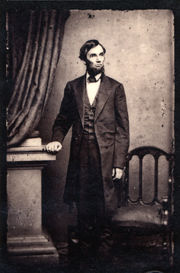
Ten percent plan
Encyclopedia

American Civil War
The American Civil War was a civil war fought in the United States of America. In response to the election of Abraham Lincoln as President of the United States, 11 southern slave states declared their secession from the United States and formed the Confederate States of America ; the other 25...
in December 1863, Abraham Lincoln
Abraham Lincoln
Abraham Lincoln was the 16th President of the United States, serving from March 1861 until his assassination in April 1865. He successfully led his country through a great constitutional, military and moral crisis – the American Civil War – preserving the Union, while ending slavery, and...
offered a model for reinstatement of Southern states called the 10 percent Reconstruction plan. It decreed that a state could be reintegrated into the Union when 10% of the 1860 vote count from that state had taken an oath of allegiance to the U.S. and pledged to abide by emancipation
Emancipation
Emancipation means the act of setting an individual or social group free or making equal to citizens in a political society.Emancipation may also refer to:* Emancipation , a champion Australian thoroughbred racehorse foaled in 1979...
. The next step in the process would be for the states to formally elect a state government. Also, a state legislature could write a new constitution, but it also had to abolish slavery forever. At that time, Lincoln would recognize the reconstructed government. By 1864, Louisiana, Tennessee, and Arkansas had established fully functioning Unionist governments.
This policy was meant to shorten the war by offering a moderate peace plan. It was also intended to further his emancipation policy by insisting that the new governments abolished slavery.
Congress reacted sharply to this proclamation of Lincoln's. Republicans feared that the planter aristocracy would be restored and the blacks would be forced back into slavery. Lincoln's reconstructive policy toward the South was lenient because he wanted to popularize his Emancipation Proclamation
Emancipation Proclamation
The Emancipation Proclamation is an executive order issued by United States President Abraham Lincoln on January 1, 1863, during the American Civil War using his war powers. It proclaimed the freedom of 3.1 million of the nation's 4 million slaves, and immediately freed 50,000 of them, with nearly...
. Lincoln feared that compelling enforcement of the proclamation could lead to the defeat of the Republican Party in the election of 1864, and that popular Democrats could overturn his proclamation. Some Republicans pushed through Congress the Wade-Davis Bill in July 1864, which outlined more stringent requirements for re-admission. This was pocket-vetoed by Lincoln after it passed.
The Radical Republicans opposed Lincoln's plan, as they thought it too lenient towards the South. They wanted more stringent requirements for Southern states' re-admission into the Union. Lincoln, however, chose not to punish the South. He wanted to preserve the Union and start rebuilding the wealth and prosperity of the country.

